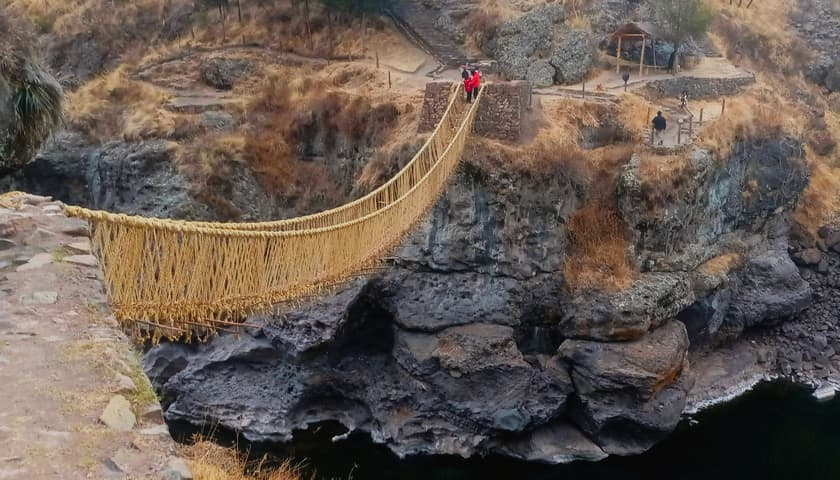The Incas built suspension bridges made of ropes and wooden plants over rivers and canyons to connect villages. The Bridge was held up by ropes anchored to the ground or trees on either side of the river.
Qeswachaka, The last handwoven Inca bridge.
The Incas built suspension bridges made of ropes and wooden plants over rivers and canyons to connect villages. The Bridge was held up by ropes anchored to the ground or trees on either side of the river.
The Inca suspension bridges were not sturdy and could only support a few people simultaneously. If too many people tried to cross it, the Bridge would collapse. However, the Incas had no other way to cross rivers, so they used these bridges.

Qeswachaka Bridge.
Today, there are still some Inca rope bridges in use. One of the last Inca Bridges continuously used since Inca times in Qeswachaka.
What is the Qeswachaka Bridge?.
Qeswachaka is one of the last remaining hand-made Inca bridges in Peru. Spanning 82 meters (269 ft) and constructed entirely of woven grass, it crosses the Apurimac River in the Cusco Region near the Qehue district. The Bridge has been rebuilt using traditional methods every year since the Inca Empire.
The Q’eswachaka Rope Bridge is a suspension bridge that spans the Apurimac River in Peru. It is made entirely of hand-woven grass ropes and has been used by the local people for centuries. The Bridge is rebuilt yearly using the same techniques passed down through generations. This Bridge is one of the last remaining examples of Inca engineering, a testament to the skill and craftsmanship of the Inca people.
Location.
The Qeswachaka bridge is located at 3700 m (12139 ft) in the Huinchhiri village, Qehue district of the Peruvian province of Canas in the Cusco region. The Bridge is built over the Apurimac River and is the only remaining example in Peru. To arrive at this attraction, you must follow the Cusco to Puno route until Combapata; you will take the road to Yanaoca and then to the Qehue district. The total duration of the trip by car is 3.5 hours.
History.
The Inca people first built the Qeswachaka bridge in the 15th century to cross the Apurimac River, which was an essential part of their trade route.
Every year, the villager of Chaupibanda, Choccayhua, Huinchiri, and Ccollana Quehue gather together in an ancient working system called MINKA, where all the villagers work for the benefit of all the community and repair the Bridge during the second week of June.
The “ritual renewal of the Q’eswachaca bridge” and the knowledge associated with its history and construction were declared as a country’s cultural heritage by the Peruvian National Institute of Culture in 2009.
In 2013, Qeswachaka was inscribed in the Intangible Cultural Heritage of Humanity UNESCO list.
Today, the Qeswachaka Bridge is a popular tourist destination. Visitors can travel by car to the Qehue district, hike, and cross the Bridge.
How was the Qeswachaka Bridge Built?.
To rebuild the Qeswachaka Bridge, which has been used for hundreds of years by the people of the Cusco region in Peru, locals use traditional Inca methods. Every year, usually in June, the Bridge is taken down, and new ropes are woven from grass harvested in the highlands. The new ropes are then used to replace the old ones, worn out from all the traffic they’ve carried over the past year. This process is called q’inti kancha, or “bridge renewal.”
It takes about 4 days to weave all the new ropes, which are then strung across the chasm using a system of pulleys. Once in place, wooden planks are laid across them to create a walking surface.
The Significance of the Qeswachaka Bridge.
The Qeswachaka Bridge is the last remaining Inca rope bridge. It was built using the same methods and materials as the other Inca bridges, which have since disappeared. The Qeswachaka Bridge is a reminder of the engineering prowess of the Inca people and their ability to create bridges that lasted for centuries.
How to get to the Qeswachaka from Cusco.
There are a few ways to get to the Qeswachaka from Cusco. The most common way is to take a guided tour from Cusco that includes a bus, tour guide, entry tickets, and meals.
Packing list for Qeswachaka.
When visiting Qeswachaka, it is important to be prepared for the journey. Here is a packing list of essential items to bring:
A backpack with comfortable straps and room for all your belongings
A water bottle and snacks to keep you hydrated and fueled during your travels
Sunscreen and a hat to protect you from the sun’s rays
Comfortable walking shoes or hiking boots
A camera to capture memories of your time at Qeswachaka
Tips for visiting Qeswachaka.
If you’re planning a trip to Qeswachaka, here are a few tips to make the most of your visit:
Timing is everything – plan your trip for the dry season (May-October) when the weather is ideal, and the river is at its lowest and blue waters.
You will go off the beaten path – traveling with a tour guide, and an organized group is better.
Be prepared for adventure – Qeswachaka is remote and rugged, so come prepared with good hiking shoes, plenty of sunscreens and insect repellent, and plenty of water.
If you are afraid of heights, we recommend not crossing the Bridge and just walking around.
